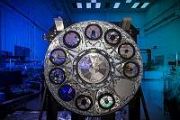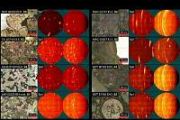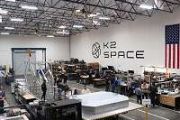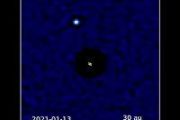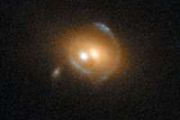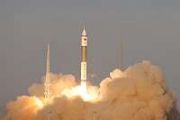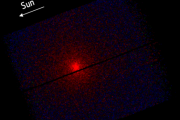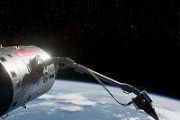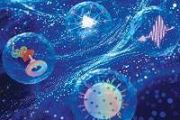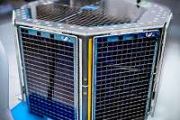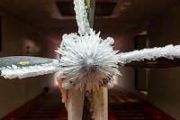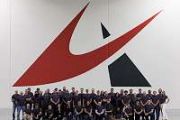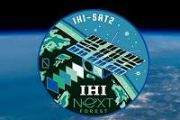
Copernical Team
First pair of Terran Orbital developed spacecraft now operating in GEO orbit
 Terran Orbital Corporation (NYSE: LLAP), a global leader in satellite-based solutions primarily serving the aerospace and defense industries, has announced mission success for the first pair of Terran Orbital-developed spacecraft operating in or around the geosynchronous orbit (GEO) belt.
The two spacecraft were built for Lockheed Martin and successfully completed their on-orbit demonstrat
Terran Orbital Corporation (NYSE: LLAP), a global leader in satellite-based solutions primarily serving the aerospace and defense industries, has announced mission success for the first pair of Terran Orbital-developed spacecraft operating in or around the geosynchronous orbit (GEO) belt.
The two spacecraft were built for Lockheed Martin and successfully completed their on-orbit demonstrat Innovative NASA alloy used for 3D printed rocket
 In March, the Relativity Space Terran 1 rocket lit up the night sky as it launched from Cape Canaveral Space Force Station in Florida. This was the first launch of a test rocket made entirely from 3D-printed parts, measuring 100 feet tall and 7.5 feet wide. A form of additive manufacturing, 3D printing is a key technology for enhancing capabilities and reducing cost. Terran 1 included nine addit
In March, the Relativity Space Terran 1 rocket lit up the night sky as it launched from Cape Canaveral Space Force Station in Florida. This was the first launch of a test rocket made entirely from 3D-printed parts, measuring 100 feet tall and 7.5 feet wide. A form of additive manufacturing, 3D printing is a key technology for enhancing capabilities and reducing cost. Terran 1 included nine addit SpaceX lights up night skies with early Thursday Falcon 9 launch
 SpaceX successfully launched a Falcon 9 rocket carrying 56 Starlink satellites early Thursday morning from Cape Canaveral Space Force Station in Florida. The Falcon 9 lifted off at the scheduled 3:31 a.m. EDT launch time, with no need for a backup launch. The 56 Starlink Internet satellites were launched from Space Launch Complex 40 and carried to low-Earth orbit.
SpaceX successfully launched a Falcon 9 rocket carrying 56 Starlink satellites early Thursday morning from Cape Canaveral Space Force Station in Florida. The Falcon 9 lifted off at the scheduled 3:31 a.m. EDT launch time, with no need for a backup launch. The 56 Starlink Internet satellites were launched from Space Launch Complex 40 and carried to low-Earth orbit. Aerovironment awarded $10M JPL to co-design and develop two helicopters for Mars Sample Return mission
 AeroVironment, Inc. (NASDAQ: AVAV) has been awarded a $10 million contract by NASA's Jet Propulsion Laboratory (JPL) to co-design and co-develop conceptual designs and engineering development units of Mars Sample Recovery Helicopter flight systems.
Future efforts could include detailed design, build, and test of qualification and flight hardware. The helicopters build upon the Ingenuity Ma
AeroVironment, Inc. (NASDAQ: AVAV) has been awarded a $10 million contract by NASA's Jet Propulsion Laboratory (JPL) to co-design and co-develop conceptual designs and engineering development units of Mars Sample Recovery Helicopter flight systems.
Future efforts could include detailed design, build, and test of qualification and flight hardware. The helicopters build upon the Ingenuity Ma European company designs a space station with artificial gravity
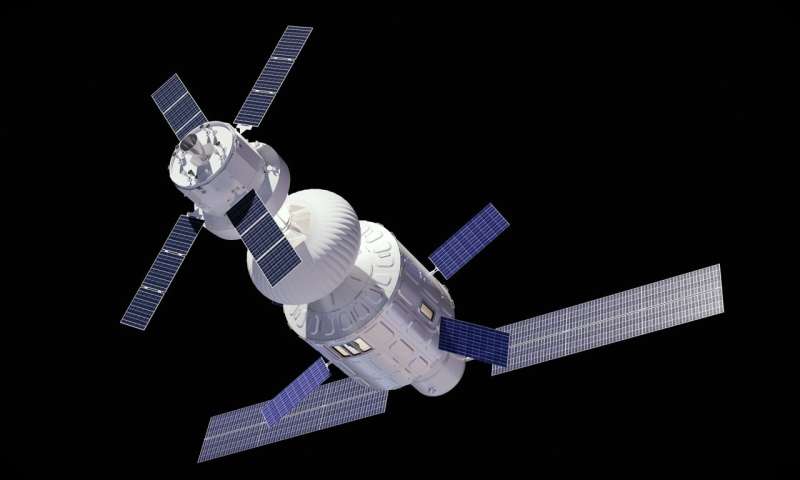
The International Space Station (ISS) is nearing the end of its service. While NASA and its partners have committed to keeping it in operation until 2030, plans are already in place for successor space stations that will carry on the ISS' legacy.
China plans to assume a leading role with Tiangong, while the India Space Research Organization (ISRO) plans to deploy its own space station by mid-decade. NASA has also contracted with three aerospace companies to design commercial space stations, including Blue Origin's Orbital Reef, the Axiom Space Station (AxS), and Starlab.
Well, buckle up. The European multinational aerospace giant Airbus has thrown its hat into the ring. In a recently-released video, the company detailed its proposal for a Multi-Purpose Orbital Module (MPOP) called the Airbus LOOP.
This modular space segment contains three decks, a centrifuge, and enough volume for a crew of four, making it suitable for future space stations and long-duration missions to Mars. The LOOP builds on the company's long history of human spaceflight programs, like the ISS Columbus Module, the Automated Transfer Vehicle (ATV), and the Orion European Service Module (ESM).
Hughes launches new HughesNet plans for small businesses
 Hughes Network Systems has announced new HughesNet plans for small businesses in the U.S. The new satellite internet service plans include features like business-grade support, express repair and free installation to support the needs of small businesses for network availability and high performance.
The plans also include low-latency HughesNet Fusion plans that seamlessly blend Geostation
Hughes Network Systems has announced new HughesNet plans for small businesses in the U.S. The new satellite internet service plans include features like business-grade support, express repair and free installation to support the needs of small businesses for network availability and high performance.
The plans also include low-latency HughesNet Fusion plans that seamlessly blend Geostation Deep-learning system explores materials' interiors from the outside
 Maybe you can't tell a book from its cover, but according to researchers at MIT you may now be able to do the equivalent for materials of all sorts, from an airplane part to a medical implant. Their new approach allows engineers to figure out what's going on inside simply by observing properties of the material's surface.
The team used a type of machine learning known as deep learning to c
Maybe you can't tell a book from its cover, but according to researchers at MIT you may now be able to do the equivalent for materials of all sorts, from an airplane part to a medical implant. Their new approach allows engineers to figure out what's going on inside simply by observing properties of the material's surface.
The team used a type of machine learning known as deep learning to c NASA awards contracts for NOAA Coronagraph Instrument Phase A Study
 NASA, on behalf of the National Oceanic and Atmospheric Administration (NOAA), has selected five firms for the Space Weather Next Lagrange 1 Series (L1 Series) Coronagraph (COR) Phase A Study. These contracted firms will provide services to help meet the objectives of NOAA's L1 Next Series.
The firms selected are Johns Hopkins Applied Physics Lab (APL), Laurel, Maryland; EO Vista, Acton, M
NASA, on behalf of the National Oceanic and Atmospheric Administration (NOAA), has selected five firms for the Space Weather Next Lagrange 1 Series (L1 Series) Coronagraph (COR) Phase A Study. These contracted firms will provide services to help meet the objectives of NOAA's L1 Next Series.
The firms selected are Johns Hopkins Applied Physics Lab (APL), Laurel, Maryland; EO Vista, Acton, M ESA recruiting for key divisional directors
 The European Space Agency is currently looking for a new Director of Connectivity and Secure Communications and new Director of Internal Services to join its executive board and support the Director General, with responsibility for relevant ESA activities and overall objectives.
b>Director of Connectivity and Secure Communications br> /b>
As Director of Connectivity and Secure Communicat
The European Space Agency is currently looking for a new Director of Connectivity and Secure Communications and new Director of Internal Services to join its executive board and support the Director General, with responsibility for relevant ESA activities and overall objectives.
b>Director of Connectivity and Secure Communications br> /b>
As Director of Connectivity and Secure Communicat SmartSat sends stellar PhD students to NASA JPL for career-boosting internships
 SmartSat Cooperative Research Centre (CRC), Australia's leading space research centre, has announced a prestigious program to fund two PhD students to undertake an intensive ten-week internship at NASA's Jet Propulsion Laboratory (JPL) in California, USA.
Aspiring space leaders Anne Bettens, from the University of Sydney, and Emily Ahern, from the University of Adelaide, have been paired w
SmartSat Cooperative Research Centre (CRC), Australia's leading space research centre, has announced a prestigious program to fund two PhD students to undertake an intensive ten-week internship at NASA's Jet Propulsion Laboratory (JPL) in California, USA.
Aspiring space leaders Anne Bettens, from the University of Sydney, and Emily Ahern, from the University of Adelaide, have been paired w 






